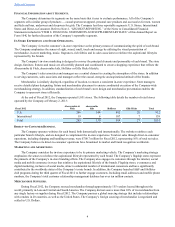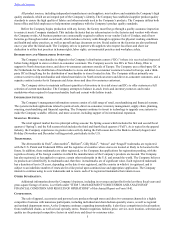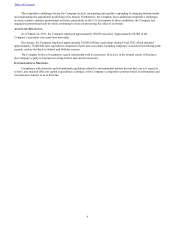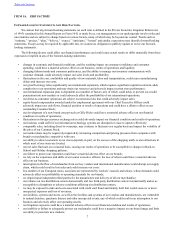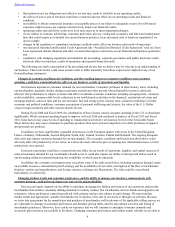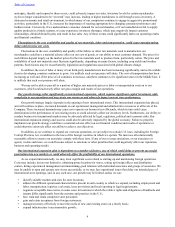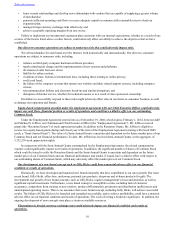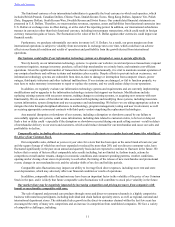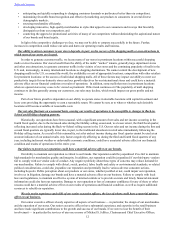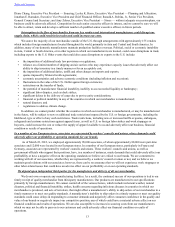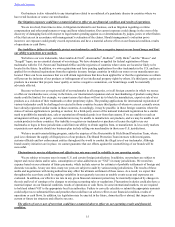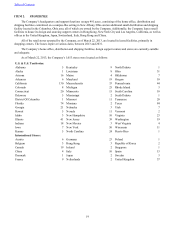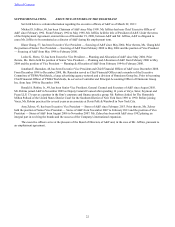Abercrombie & Fitch 2013 Annual Report Download - page 14
Download and view the complete annual report
Please find page 14 of the 2013 Abercrombie & Fitch annual report below. You can navigate through the pages in the report by either clicking on the pages listed below, or by using the keyword search tool below to find specific information within the annual report.
14
Additionally, while we utilize third-party compliance auditors to visit and monitor the operations of our manufacturers,
we do not have control of the independent manufacturers or their labor practices. As a result, the risk remains that one or more
of our manufacturers will not adhere to our global compliance standards and violate labor laws or other laws, including
consumer and product safety laws. Non-governmental organizations might attempt to create an unfavorable impression of our
sourcing practices or the practices of some of our vendors or manufacturers that could harm our image. If either of these events
occur, we could lose customer goodwill and favorable brand recognition.
The efficient operation of our stores and direct-to-consumer business depends on the timely receipt of merchandise from
our distribution centers. We deliver our merchandise to our stores and direct-to-consumer customers using independent third
parties. We utilize primarily one contract carrier to ship merchandise and related materials to our North American stores and
direct-to-consumer customers, and a separate contract carrier for our European and Asian stores and direct-to-consumer
customers. The independent third parties employ personnel that may be represented by labor unions. Disruptions in the delivery
of merchandise or work stoppages by associates or contractors of any of these third parties could delay the timely receipt of
merchandise. There can be no assurance that such stoppages or disruptions will not occur in the future. Any failure by a third
party to respond adequately to our distribution needs would disrupt our operations and could have a material adverse effect on
our financial condition or results of operations. Furthermore, we are susceptible to increases in fuel costs which may increase
the cost of distribution. If we are not able to pass this cost on to our customers, our financial condition and results of operations
could be adversely affected.
Our reliance on two distribution centers domestically and two third-party distribution centers internationally makes us
susceptible to disruptions or adverse conditions affecting our distribution centers.
Our two distribution centers located in New Albany, Ohio, manage the receipt, storage, sorting, packing and distribution
of merchandise to our North American stores and to our North American and Asian direct-to-consumer customers. We also use
a third-party distribution center in the Netherlands to manage the receipt, storage, sorting, packing and distribution of
merchandise delivered to our stores and direct-to-consumer customers in Europe and a third-party distribution center in Hong
Kong to manage receipt, storage, sorting, packing and distribution of merchandise delivered to our stores in Asia. As a result,
our operations are susceptible to local and regional factors, such as system failures, accidents, economic and weather
conditions, natural disasters, demographic and population changes, as well as other unforeseen events and circumstances. If our
distribution operations were disrupted, our ability to replace inventory in our stores and process direct-to-consumer orders
could be interrupted and sales could be negatively impacted.
We may be exposed to risks and costs associated with credit card fraud and identity theft that would cause us to incur
unexpected expenses and loss of revenues.
A significant portion of our customer orders are placed through our websites. In addition, a significant portion of sales
made through our retail stores requires the collection of certain customer data, such as credit card information. In order for our
sales channels to function and develop successfully, we and other parties involved in processing customer transactions must be
able to transmit confidential information, including credit card information, securely over public networks. Third parties may
have the technology or knowledge to breach the security of customer transaction data. Although we have security measures
related to our systems and the privacy of our customers, we cannot guarantee these measures will effectively prevent others
from obtaining unauthorized access to our information and our customers’ information. Any person who circumvents our
security measures could destroy or steal valuable information or disrupt our operations. While one has not occurred, a security
breach could cause customers to lose confidence in the security of our websites or stores and choose not to purchase from us.
Any security breach could also expose us to risks of data loss, litigation and liability, and could seriously disrupt operations and
harm our reputation, any of which could adversely affect our financial condition and results of operations.
In addition, state, federal and foreign governments are increasingly enacting laws and regulations to protect consumers
against identity theft. These laws and regulations will likely increase the costs of doing business and if we fail to implement
appropriate security measures, or to detect and provide prompt notice of unauthorized access as required by some of these laws
and regulations, we could be subject to potential claims for damages and other remedies, which could adversely affect our
business and results of operations.
Our facilities, systems and stores, as well as the facilities and systems of our vendors and manufacturers, are vulnerable
to natural disasters, pandemic disease and other unexpected events, any of which could result in an interruption to our
business and adversely affect our operating results.
Our retail stores, corporate offices, distribution centers, infrastructure projects and direct-to-consumer operations, as well
as the operations of our vendors and manufacturers, are vulnerable to damage from natural disasters, pandemic disease and
other unexpected events. If any of these events result in damage to our facilities, systems or stores, or the facilities or systems
of our vendors or manufacturers, we may experience interruptions in our business until the damage is repaired, resulting in the
potential loss of customers and revenues. In addition, we may incur costs in repairing any damage which exceeds our
applicable insurance coverage.
Table of Contents


